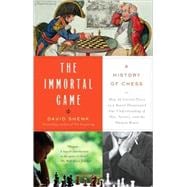
Note: Supplemental materials are not guaranteed with Rental or Used book purchases.
Purchase Benefits
What is included with this book?
| Prologue | p. XV |
| Introduction | p. 1 |
| Piece and Mows | p. 9 |
| Openings: (When: We Come From) | |
| 'Understanding Is the Essential Weapon': Chess and Our Origins | p. 13 |
| The Immortal Game: Move 1 | p. 21 |
| House of Wisdom: Chess and the Muslim Renaissance | p. 29 |
| The Immortal Game: Move 2 | p. 39 |
| The Morals of Men and the Duties of Nobles and Commoners: Chess and Medieval Obligation | p. 43 |
| The Immortal Game: Move 3 | p. 60 |
| Making Men Circumspect: Modern Chess, the Accumulation of Knowledge, and the March to Infinity | p. 65 |
| The Immortal Game: Moves 4 and 5 | p. 76 |
| Middlegame: (Who We Are) | |
| Benjamin Franklin's Opera: Chess and the Enlightenment | p. 87 |
| The Immortal Game: Moves 6 and 7 | p. 99 |
| The Emperor and the Immigrant: Chess and the Unexpected Gifts of War | p. 107 |
| The Immortal Game: Moves 8 and 9 | p. 117 |
| Chunking and Tasking: Chess and the Working Mind | p. 123 |
| The Immortal Game: Moves 10 and 11 | p. 134 |
| "Into Its Vertiginous Depths": Chess and the Shattered Mind | p. 141 |
| The Immortal Game: Moves 12-16 | p. 151 |
| A Victorious Synthesis: Chess and Totalitarianism in the Twentieth Century | p. 163 |
| The Immortal Game: Moves 17-19 | p. 178 |
| Beautiful Problems: Chess and Modernity | p. 185 |
| The Immortal Game: Moves 20 and 21 | p. 193 |
| Endgame (Where We Are Going) | |
| "We Are Sharing Our World with Another Species, One That Gets Smarter and More Independent Every Year": Chess and the New Machine Intelligence | p. 199 |
| The Immortal Game: Moves 22 and 23 (Checkmate) | p. 222 |
| The Next War: Chess and the Future of Human Intelligence | p. 227 |
| Coda | p. 239 |
| Acknowledgments | p. 241 |
| The Rules of Chess | p. 245 |
| The Immortal Game (Recap) and Five Other Great Games from History | p. 255 |
| Benjamin Franklin's "The Morals of Chess" | p. 281 |
| Sources and Notes | p. 287 |
| Index | p. 315 |
| Table of Contents provided by Ingram. All Rights Reserved. |
The New copy of this book will include any supplemental materials advertised. Please check the title of the book to determine if it should include any access cards, study guides, lab manuals, CDs, etc.
The Used, Rental and eBook copies of this book are not guaranteed to include any supplemental materials. Typically, only the book itself is included. This is true even if the title states it includes any access cards, study guides, lab manuals, CDs, etc.
Excerpted from The Immortal Game: A History of Chess or How 32 Carved Pieces on a Board Illuminated Our Understanding of War, Art, Science, and the Human Brain by David Shenk
All rights reserved by the original copyright owners. Excerpts are provided for display purposes only and may not be reproduced, reprinted or distributed without the written permission of the publisher.